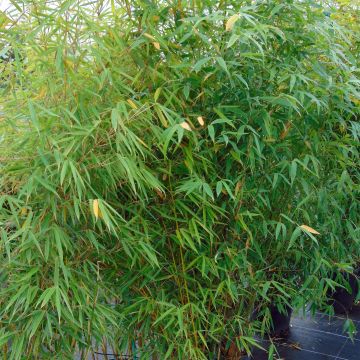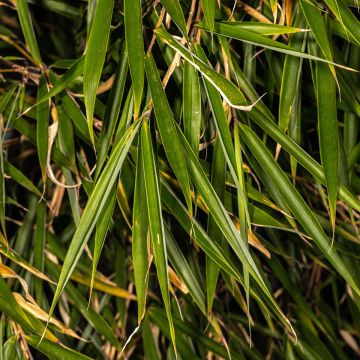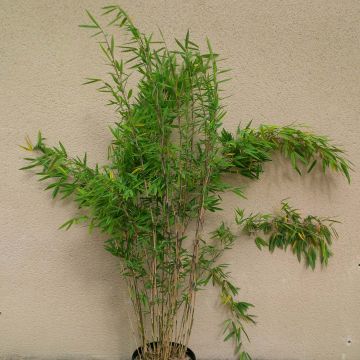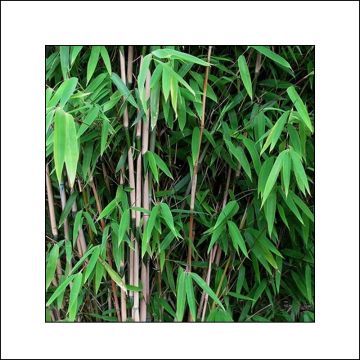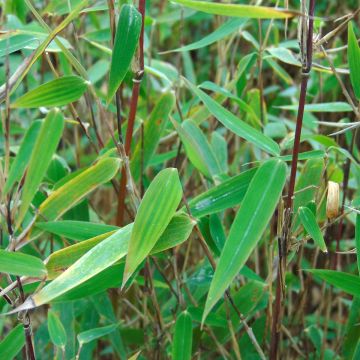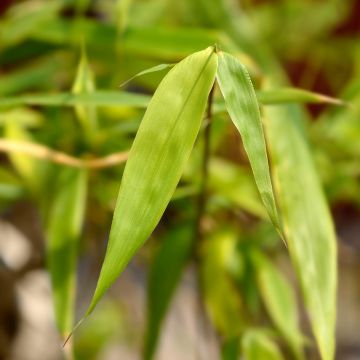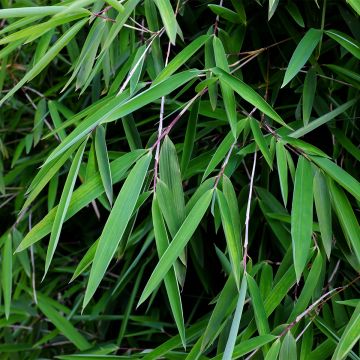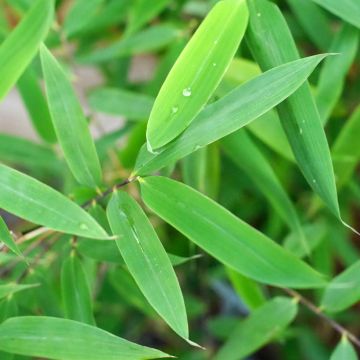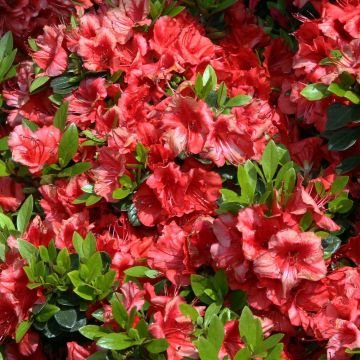

Fargesia papyrifera


Fargesia papyrifera


Fargesia papyrifera


Fargesia papyrifera
Fargesia papyrifera
Fargesia papyrifera
Blue Bamboo
Disappointing for the price, the bamboo is so weak after one year and not much is happening apart from it withering... And yet, I am in the business, a disappointed customer along with me!
Mathilde, 21/03/2022
Why not try an alternative variety in stock?
View all →This plant carries a 24 months recovery warranty
More information
We guarantee the quality of our plants for a full growing cycle, and will replace at our expense any plant that fails to recover under normal climatic and planting conditions.
From €5.90 for pickup delivery and €6.90 for home delivery
Express home delivery from €8.90.
Does this plant fit my garden?
Set up your Plantfit profile →
Description
The Fargesia papyrifera is a stunning bamboo plant with blue culms that is non-invasive and suitable for growth in the ground in milder areas. This Chinese bamboo species develops young canes covered with a dense bluish bloom that reveals a striking steel-blue shine. The foliage is light and matte green, and will remain evergreen depending on the severity of the winter. If the plant's growing conditions are met, it can reach heights of up to 6 to 8 metres (19 feet 8 inches or 26 feet 2 inches). Like all Fargesia species, it slowly spreads over the years but does not become invasive. You can exhibit it as a standalone plant, like a work of art, or plant it in a pot on the terrace.
The Fargesia papyrifera (synonym Borinda papyrifera) is a plant of the Poaceae family, a type of grass with woody stems that develops from a non-invasive rhizomatous rootstock, called clump-forming. In this type of bamboo, the rhizomes with very short internodes develop slowly on the periphery of the stump, which gradually widens, but they also develop towards the centre of the clump, which remains very dense without thinning out in the middle. The Fargesia papyrifera is native to the western part of the Chinese province of Yunnan, where it grows in mountain forests. Depending on the growing conditions, it can withstand temperatures as low as -12°C (10.4 °F), according to some sources. It thrives in shade or semi-shade, in deep, moist, and humus-rich soils.
The Fargesia papyrifera is an upright bamboo plant that can spread up to 5 metres (16 feet 5 inches) in the ground, sometimes even more. The culms or canes of this species are known to be particularly thick, with a diameter of 3 to 4 cm (1.2 to 1.6 in) and reaching a height of 8 metres (26 feet 2 inches). Unlike other bamboo types, these culms are solid, not hollow, and have a beautiful bluish colour rarely observed in the plant world. The bluish stems are covered with a white powder at the nodes, then take on a more greyish colour. Each node bears a light mahogany sheath that remains attached to the stem for a long time, creating a beautiful colour combination with the blue-grey. In the first year, the culms only bear a few leaves, but the foliage is semi-evergreen and becomes more abundant towards the top of the culms, which makes them very visible. The leaves are lanceolate and tapering at the end, with a slightly greyish, light green colour and a matte finish. To enhance the appearance of small bamboo plants, the best time to prune them is in late winter.
The Fargesia papyrifera is a collector's bamboo, which can be showcased in the garden or on the terrace. Whether in open ground or in pots, it deserves a prime spot, as a standalone plant at the edge of a pathway, in the centre of the garden, or in a carefully chosen large pot that can be stored during the winter in cold and humid regions. It can be paired with other exotic-looking plants such as the Giant Hosta Empress Wu, the Melianthus major, giant cannas, or the Giant Dahlia Imperialis that will lean its tall floral stems on the sturdy culms of this Fargesia. The climbing Aster Ampelaster carolinianus would also be a fantastic choice as it will enliven the garden with pink stars and red leaves at the end of the season and throughout the winter.
Report an error about the product description
Fargesia papyrifera in pictures
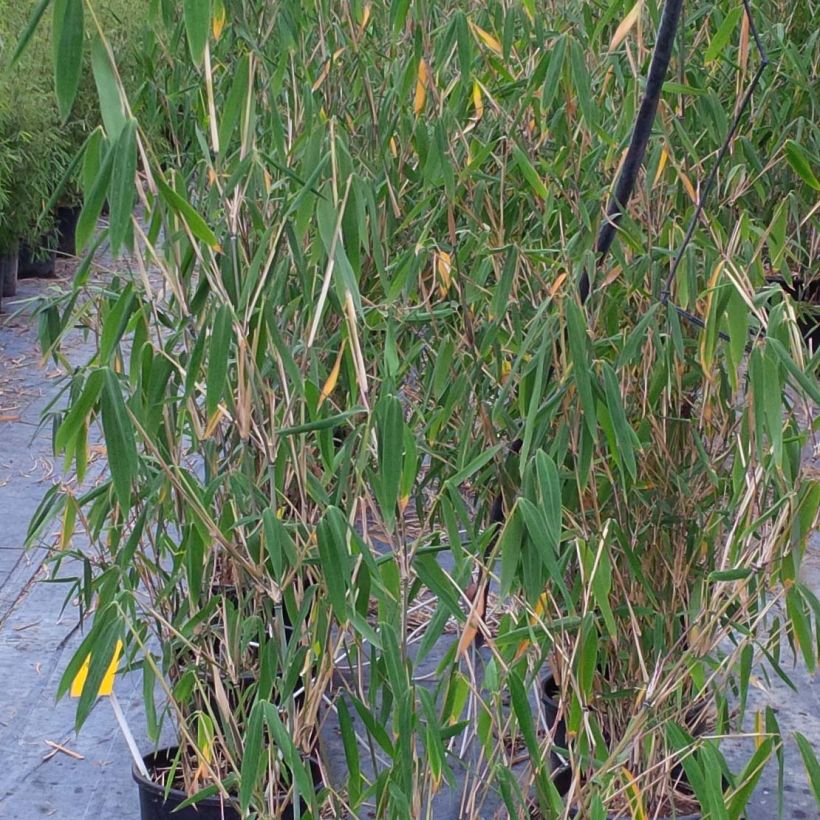

Plant habit
Foliage
Botanical data
Fargesia
papyrifera
Poaceae
Blue Bamboo
China
Other Non-spreading Bamboos
Planting and care
The Fargesia papyrifera bamboo plant does well in partially or fully shaded areas, especially in warm climates. It's sensitive to too much sun and drought, so keeping it in a shady position and well-watered is essential. When planting, choose moist, rich soil, and avoid limestone. It's best to plant in the spring or autumn in mild climates and leave enough space to grow over time, as it can spread up to 10 metres (32 feet 10 inches). The mature plant requires about 20 litres of water per week during hot periods and 10 litres for the rest of the year. If you choose to plant it in a pot, monitor watering carefully and add two handfuls of fertiliser at the base of the bamboo from early March to mid-April. This will help keep its foliage green. Be aware that slugs can eat young shoots. Unlike other Fargesia types, this non-invasive bamboo doesn't require a rhizome barrier when planting. It retains its green foliage in winter but may lose some leaves depending on the temperature throughout the year.
Planting period
Intended location
Care
-
, onOrder confirmed
Reply from on Promesse de fleurs
Evergreen shrubs
Haven't found what you were looking for?
Hardiness is the lowest winter temperature a plant can endure without suffering serious damage or even dying. However, hardiness is affected by location (a sheltered area, such as a patio), protection (winter cover) and soil type (hardiness is improved by well-drained soil).

Photo Sharing Terms & Conditions
In order to encourage gardeners to interact and share their experiences, Promesse de fleurs offers various media enabling content to be uploaded onto its Site - in particular via the ‘Photo sharing’ module.
The User agrees to refrain from:
- Posting any content that is illegal, prejudicial, insulting, racist, inciteful to hatred, revisionist, contrary to public decency, that infringes on privacy or on the privacy rights of third parties, in particular the publicity rights of persons and goods, intellectual property rights, or the right to privacy.
- Submitting content on behalf of a third party;
- Impersonate the identity of a third party and/or publish any personal information about a third party;
In general, the User undertakes to refrain from any unethical behaviour.
All Content (in particular text, comments, files, images, photos, videos, creative works, etc.), which may be subject to property or intellectual property rights, image or other private rights, shall remain the property of the User, subject to the limited rights granted by the terms of the licence granted by Promesse de fleurs as stated below. Users are at liberty to publish or not to publish such Content on the Site, notably via the ‘Photo Sharing’ facility, and accept that this Content shall be made public and freely accessible, notably on the Internet.
Users further acknowledge, undertake to have ,and guarantee that they hold all necessary rights and permissions to publish such material on the Site, in particular with regard to the legislation in force pertaining to any privacy, property, intellectual property, image, or contractual rights, or rights of any other nature. By publishing such Content on the Site, Users acknowledge accepting full liability as publishers of the Content within the meaning of the law, and grant Promesse de fleurs, free of charge, an inclusive, worldwide licence for the said Content for the entire duration of its publication, including all reproduction, representation, up/downloading, displaying, performing, transmission, and storage rights.
Users also grant permission for their name to be linked to the Content and accept that this link may not always be made available.
By engaging in posting material, Users consent to their Content becoming automatically accessible on the Internet, in particular on other sites and/or blogs and/or web pages of the Promesse de fleurs site, including in particular social pages and the Promesse de fleurs catalogue.
Users may secure the removal of entrusted content free of charge by issuing a simple request via our contact form.
The flowering period indicated on our website applies to countries and regions located in USDA zone 8 (France, the United Kingdom, Ireland, the Netherlands, etc.)
It will vary according to where you live:
- In zones 9 to 10 (Italy, Spain, Greece, etc.), flowering will occur about 2 to 4 weeks earlier.
- In zones 6 to 7 (Germany, Poland, Slovenia, and lower mountainous regions), flowering will be delayed by 2 to 3 weeks.
- In zone 5 (Central Europe, Scandinavia), blooming will be delayed by 3 to 5 weeks.
In temperate climates, pruning of spring-flowering shrubs (forsythia, spireas, etc.) should be done just after flowering.
Pruning of summer-flowering shrubs (Indian Lilac, Perovskia, etc.) can be done in winter or spring.
In cold regions as well as with frost-sensitive plants, avoid pruning too early when severe frosts may still occur.
The planting period indicated on our website applies to countries and regions located in USDA zone 8 (France, United Kingdom, Ireland, Netherlands).
It will vary according to where you live:
- In Mediterranean zones (Marseille, Madrid, Milan, etc.), autumn and winter are the best planting periods.
- In continental zones (Strasbourg, Munich, Vienna, etc.), delay planting by 2 to 3 weeks in spring and bring it forward by 2 to 4 weeks in autumn.
- In mountainous regions (the Alps, Pyrenees, Carpathians, etc.), it is best to plant in late spring (May-June) or late summer (August-September).
The harvesting period indicated on our website applies to countries and regions in USDA zone 8 (France, England, Ireland, the Netherlands).
In colder areas (Scandinavia, Poland, Austria...) fruit and vegetable harvests are likely to be delayed by 3-4 weeks.
In warmer areas (Italy, Spain, Greece, etc.), harvesting will probably take place earlier, depending on weather conditions.
The sowing periods indicated on our website apply to countries and regions within USDA Zone 8 (France, UK, Ireland, Netherlands).
In colder areas (Scandinavia, Poland, Austria...), delay any outdoor sowing by 3-4 weeks, or sow under glass.
In warmer climes (Italy, Spain, Greece, etc.), bring outdoor sowing forward by a few weeks.

































